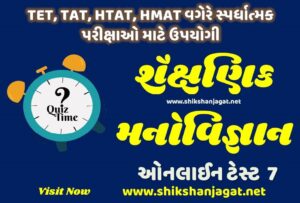Educational Psychology Online Test 7 Educational psychology is the branch of psychology that focuses on understanding how people learn and how to best facilitate the learning process. It is concerned with understanding how individuals differ in their learning and how to design educational experiences that are tailored to the needs of different learners.
As we are aware that Top 20 Psychology GK Questions In Gujarati PDF is very important area in all the competitive exam held in the country. Most of the aspirants feel difficulty in scoring good marks in it. Now a days, a good knowledge of general awareness is very important in clearing any competitive exam. To over come all this you should have a understanding of the things happening around you.
Educational Psychology Online Test 7
Here’s a blog of Social Science Quiz and GK Questions for TET Exams. As you know Economics GK questions and answers are the very useful topic for Competitive Exams as like Basic GK Questions. Educational Psychology online test for TET. TAT, HTAT, HMAT exams.
Educational psychology MCQ with answers for Teacher Eligibility Test – TET, Bin Sachivalay Clerk, GPSC, TAT, HTAT, HMAT, Talati, Gram Sevak, ASTO. These questions will help you to prepare your Competitive examinations for Social Study papers.
Educational Psychology Online Test 7
There are several key concepts in educational psychology that are important to understand in order to effectively facilitate learning. These include:
- Motivation: Motivation is the driving force that inspires people to engage in certain behaviors. It is an important factor in learning because it helps determine how much effort and attention a learner will put into the learning process.
- Attention: Attention is the process of focusing on a specific stimulus or task. In order to learn effectively, it is important for students to pay attention to the material being presented.
- Memory: Memory is the process of encoding, storing, and retrieving information. In order to learn, it is important for students to be able to retain and retrieve information from their memory.
- Perception: Perception is the process of interpreting sensory information. In learning, it is important for students to be able to accurately interpret and understand the information being presented to them.
- Problem-solving: Problem-solving is the process of identifying and addressing a problem. In learning, it is important for students to be able to identify and solve problems related to the material being studied.
- Creativity: Creativity is the ability to generate new and innovative ideas. In learning, it is important for students to be able to think creatively and come up with original solutions to problems.
Educational Psychology Online Test 7
There are several theories of learning that have been proposed by educational psychologists to explain how people learn. These theories include:
Also Check :
- Educational Psychology Online Test 6
- Educational Psychology Online Test 5
- Educational Psychology Online Test 4
- Educational Psychology Online Test 3

- Behaviorism: The behaviorist perspective emphasizes the role of reinforcement in shaping behavior. According to this perspective, learning occurs when a behavior is followed by a reinforcing consequence, such as a reward.
- Cognitive theory: The cognitive perspective emphasizes the role of mental processes in learning. According to this perspective, learning occurs when new information is processed and stored in memory.
- Constructivism: The constructivist perspective emphasizes the role of the learner in constructing their own understanding of the world. According to this perspective, learning occurs when individuals actively construct their own understanding of new information based on their prior knowledge and experiences.
Educational Psychology Online Test 7
There are several factors that can impact the learning process. These include:
- Learner characteristics: The characteristics of the learner, such as their age, cognitive abilities, and prior knowledge, can influence how they learn.
- Learning environment: The physical and social environment in which learning takes place can impact how effectively a learner absorbs new information.
- Instructional strategies: The methods and techniques used to present new information can influence how effectively a learner absorbs and retains that information.
Educational Psychology Online Test 7
Educational psychology is a crucial field that helps educators understand how people learn and how to design educational experiences that are tailored to the needs of different learners. By understanding key concepts in educational psychology, such as motivation, attention, memory, and problem-solving, educators can create effective learning environments and instructional strategies that facilitate the learning process.
20 Marks Online test of Educational Psychology. This will help you a lot for upcoming TET, TAT, HTAT, HMAT exams. Give test and check your score.
To Join In Our Whatsapp Group : Click Here

